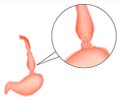Research has shown that nearly 1 percent of all emergency room visits are prompted by near-death experiences in infants.

Now, a study of these apparent life-threatening events — called ALTEs for short — suggests that infants who experience them have abnormal regulation of esophageal and airway function compared to healthy babies. The findings, published online March 28 in the Journal of Pediatrics by a team in The Research Institute at Nationwide Children's Hospital, offer new information about the mechanisms behind ALTEs and what clinicians and parents can do to avoid them.
The research, led by Sudarshan Jadcherla, MD, principal investigator in the Center for Perinatal Research, compared 10 infants who experienced an ALTE and 10 healthy babies using innovative tools that track the concurrent functions of the infants' upper digestive tracts and airways. They found that infants with a previous near-death experience were more likely to have pauses in breathing, gasping breaths, less effective upper airway protection, delays in clearing their airways and difficulty coordinating swallowing and respiratory interactions.
"Previously, these life-threatening events were thought to be due to gastroesophageal reflux disease (GERD), and acid-suppressive treatment for that was often begun," says Dr. Jadcherla, who is also the director of the Neonatal and Infant Feeding Disorders Program and the Neonatal Aerodigestive Pulmonary Program at Nationwide Children's. "But our study identifies the dysfunctions in the aerodigestive tract — instead of GERD-centered mechanisms — as the real therapeutic targets for these babies."
Evaluating and accommodating these problems of esophageal function instead of initiating GERD medication (unless there is specific evidence of the condition) may be the key to preventing future near-death events for at-risk infants, he suggests.
"These infants' respiratory limitations are generally due to immaturity of functional neural networks involved with swallowing and airway safety," Dr. Jadcherla says. "The treatment for managing them is patience and perseverance with the quality of oral feeding."
Advertisement
"For infants with esophageal function difficulties, proper positioning, proper feeding methods, taking time with the baby during oral feeding and allowing time for maturation to heal their problems are essential to protecting these babies from ALTEs," Dr. Jadcherla says. "We need to be patient in the care of such vulnerable little patients."
Advertisement
"Gasping can be a mechanism for self-resuscitation when associated with swallowing, restoring respiratory normalcy," says Dr. Jadcherla, also a professor of pediatrics at The Ohio State University College of Medicine. "Although there can be many theories for death in any given infant with SIDS, the precise mechanisms or therapeutic targets in such infants when they are alive remain elusive. Understanding the aerodigestive mechanisms in the context of airway protection and feeding safety may offer hope."
Source-Eurekalert










